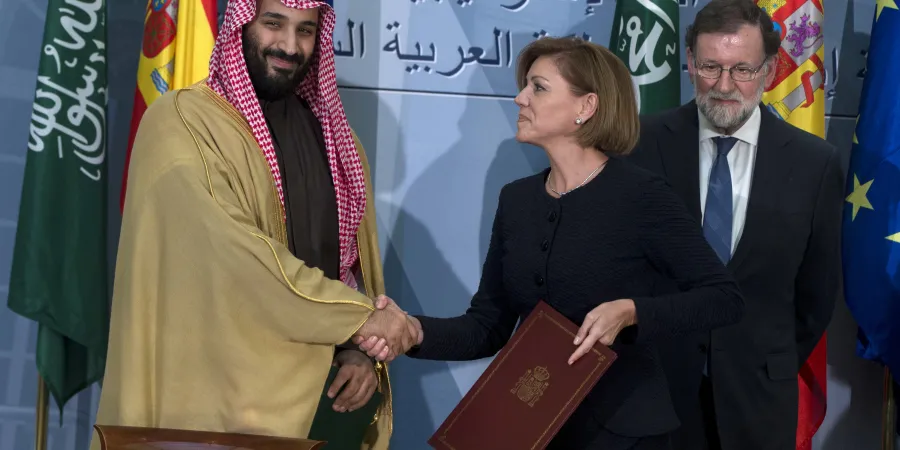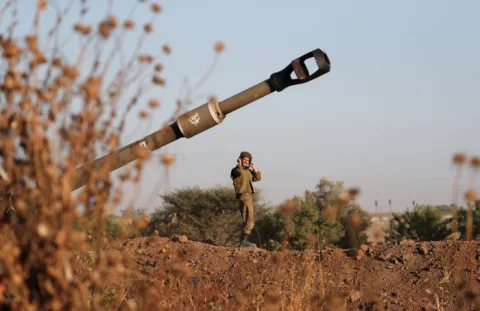Saudi Arabia, Spain Ink $2.2B Deal for Avante 2200 Corvettes
Saudi Arabia and Spain signed a $2.2 billion framework agreement on defense cooperation. The Kingdom will buy five Avante 2200 Corvettes from the Spanish state-owned shipbuilder Navantia
Dr. Shaul Shay
| 15/04/2018
Saudi Arabia and Spain signed six agreements, memorandums and bilateral deals during the official visit of Saudi Crown Prince Mohammed bin Salman last week.
The Saudi Arabian Military Industries (SAMI) and Spanish firm Navantia on April 12, 2018, signed a Memorandum of Agreement (MoA) to create a joint venture that will manage and localize naval combat systems activity including integration and installation. The MoA was signed by Ahmed Al-Khateeb, Chairman of SAMI, and Esteban García Vilasánchez, Chairman of Navantia.
Spain and Saudi Arabia also inked a Letter of Intent (LoI) to design and build five Avante 2200 corvettes including Combat Management System, for the Royal Saudi Naval Forces (RSNF). The deal is estimated at 1.8 billion euros ($2.2 billion), and the construction would take five years. The construction of the vessels, which will be managed by Cadiz and Ferrol shipyards, would take five years and involve 6,000 direct and indirect workers.
The joint venture’s first engagement will be on the five Avante 2200 corvettes, but the new company will also be involved in future naval programs, Navantia announced.
Once operational, new joint venture (JV) will focus on program management and combat system integration and installation, system engineering, system architecture, hardware design, and software development, testing and verification, prototyping, simulation, and modeling.
Saudi Arabia has issued a tender for the purchase of corvettes several years ago, in which French and the US companies were also competing. Saudi Arabia’s purchase of Spanish corvettes had been negotiated since 2015.
News of the acquisition emerged in November 2016 when it was reported that Navantia was selected to build five corvettes based on the offshore patrol vessels that the shipbuilder delivered to Venezuela.
The Avante 2200 Corvette
Navantia has built four of the ships for the Spanish Navy (Avante 3000) and four units of each class for the Venezuelan Navy (Avante 2200 and Avante 1400).
According to shipbuilder specifications, the Avante 2200 vessel measures 98.9 meters in length, displaces 2,500 tons and has a maximum speed of 25 knots. The vessel has a crew capacity of 92. It can accommodate a 10t class helicopter and can deploy two 5.5m Rigid-Hulled Inflatable Boats (RHIBs, lightweight, high-performance powerboats constructed with a solid hull, and inflatable tubes or ‘sponsors’ around the outer edge).
The Avante 2200 can perform a variety of missions, such as surveillance and protection of EEZs, protection of maritime traffic, defense of strategic interests, search and rescue operations, support for other units and humanitarian actions, control of marine pollution, fight against smuggling, drug trafficking and illegal immigration, surveillance and gathering of operational and environmental intelligence, surface defense and passive electronic warfare.
The Saudi-Spanish Relations
Spain’s King Felipe VI arrived on January 15, 2017, for a three-day official visit in Saudi Arabia. He was welcomed by King Salman at the Al-Yamama palace in Riyadh. Felipe’s father, Juan Carlos, who reigned from 1975 to 2014, has close ties to the Saudi royal family.
On the sidelines of King’s Felipe visit to Riyadh, a meeting was held between Saudi Minister of State Musaed Al-Aiban and Spanish Secretary of State for Defense Augustin Conde.
A Spanish consortium, Al-Shoula, is building a high-speed railway across the desert to link the holy cities of Mecca and Medina. The project is behind schedule and is now set to open in 2018. Spanish construction group FCC leads one of three consortia building a $22.5 billion rapid transit system in the Saudi capital.
Summary
In 2017, Saudi budget allocated 191 billion riyals ($51 billion) for military spending including equipment and weaponry, down from 205 billion riyals spent in 2016. A separate budget allocated 97 billion riyals to pay for new naval bases for the Border Guards, and other security projects. Spain is the seventh largest arms exporter in the world, and Saudi Arabia is one of the biggest buyers of military hardware.
In 2017, the deputy crown prince and defense minister, Prince Mohammed bin Salman, launched his Vision 2030 reform scheme to boost jobs and revenue to prepare for a future with lower oil income. Saudi Arabia’s Public Investment Fund (PIF) announced on May 17, 2017, the launch of a state-owned military industrial company. The Saudi Arabian Military Industries (SAMI) is part of the kingdom’s 2030 Vision.
The move could alter decades of practice in which Saudi Arabia, one of the world’s largest buyers of foreign arms, and other Gulf Arab states recycled a major part of their oil wealth back into Western economies via arms purchases and investments.
The chairman of SAMI explained that the agreement with Navantia comes in line with Saudi Arabia’s Vision 2030 and following the announcement of Crown Prince Mohammed bin Salman to localize 50 percent of the total military spending by 2030.
The MoA will further solidify the relationship between Navantia and Saudi Arabian Military Industry (SAMI) Company. The resulting JV will contribute to maintaining the readiness of the Saudi military fleet. In addition, the agreement will create approximately 1,000 jobs and training opportunities for Saudi youth, and augment the participation of Saudi nationals in the industry, contributing towards the objectives of the Kingdom's comprehensive Vision 2030 plan.
Saudi Arabia and Spain signed a $2.2 billion framework agreement on defense cooperation. The Kingdom will buy five Avante 2200 Corvettes from the Spanish state-owned shipbuilder Navantia
Saudi Arabia and Spain signed six agreements, memorandums and bilateral deals during the official visit of Saudi Crown Prince Mohammed bin Salman last week.
The Saudi Arabian Military Industries (SAMI) and Spanish firm Navantia on April 12, 2018, signed a Memorandum of Agreement (MoA) to create a joint venture that will manage and localize naval combat systems activity including integration and installation. The MoA was signed by Ahmed Al-Khateeb, Chairman of SAMI, and Esteban García Vilasánchez, Chairman of Navantia.
Spain and Saudi Arabia also inked a Letter of Intent (LoI) to design and build five Avante 2200 corvettes including Combat Management System, for the Royal Saudi Naval Forces (RSNF). The deal is estimated at 1.8 billion euros ($2.2 billion), and the construction would take five years. The construction of the vessels, which will be managed by Cadiz and Ferrol shipyards, would take five years and involve 6,000 direct and indirect workers.
The joint venture’s first engagement will be on the five Avante 2200 corvettes, but the new company will also be involved in future naval programs, Navantia announced.
Once operational, new joint venture (JV) will focus on program management and combat system integration and installation, system engineering, system architecture, hardware design, and software development, testing and verification, prototyping, simulation, and modeling.
Saudi Arabia has issued a tender for the purchase of corvettes several years ago, in which French and the US companies were also competing. Saudi Arabia’s purchase of Spanish corvettes had been negotiated since 2015.
News of the acquisition emerged in November 2016 when it was reported that Navantia was selected to build five corvettes based on the offshore patrol vessels that the shipbuilder delivered to Venezuela.
The Avante 2200 Corvette
Navantia has built four of the ships for the Spanish Navy (Avante 3000) and four units of each class for the Venezuelan Navy (Avante 2200 and Avante 1400).
According to shipbuilder specifications, the Avante 2200 vessel measures 98.9 meters in length, displaces 2,500 tons and has a maximum speed of 25 knots. The vessel has a crew capacity of 92. It can accommodate a 10t class helicopter and can deploy two 5.5m Rigid-Hulled Inflatable Boats (RHIBs, lightweight, high-performance powerboats constructed with a solid hull, and inflatable tubes or ‘sponsors’ around the outer edge).
The Avante 2200 can perform a variety of missions, such as surveillance and protection of EEZs, protection of maritime traffic, defense of strategic interests, search and rescue operations, support for other units and humanitarian actions, control of marine pollution, fight against smuggling, drug trafficking and illegal immigration, surveillance and gathering of operational and environmental intelligence, surface defense and passive electronic warfare.
The Saudi-Spanish Relations
Spain’s King Felipe VI arrived on January 15, 2017, for a three-day official visit in Saudi Arabia. He was welcomed by King Salman at the Al-Yamama palace in Riyadh. Felipe’s father, Juan Carlos, who reigned from 1975 to 2014, has close ties to the Saudi royal family.
On the sidelines of King’s Felipe visit to Riyadh, a meeting was held between Saudi Minister of State Musaed Al-Aiban and Spanish Secretary of State for Defense Augustin Conde.
A Spanish consortium, Al-Shoula, is building a high-speed railway across the desert to link the holy cities of Mecca and Medina. The project is behind schedule and is now set to open in 2018. Spanish construction group FCC leads one of three consortia building a $22.5 billion rapid transit system in the Saudi capital.
Summary
In 2017, Saudi budget allocated 191 billion riyals ($51 billion) for military spending including equipment and weaponry, down from 205 billion riyals spent in 2016. A separate budget allocated 97 billion riyals to pay for new naval bases for the Border Guards, and other security projects. Spain is the seventh largest arms exporter in the world, and Saudi Arabia is one of the biggest buyers of military hardware.
In 2017, the deputy crown prince and defense minister, Prince Mohammed bin Salman, launched his Vision 2030 reform scheme to boost jobs and revenue to prepare for a future with lower oil income. Saudi Arabia’s Public Investment Fund (PIF) announced on May 17, 2017, the launch of a state-owned military industrial company. The Saudi Arabian Military Industries (SAMI) is part of the kingdom’s 2030 Vision.
The move could alter decades of practice in which Saudi Arabia, one of the world’s largest buyers of foreign arms, and other Gulf Arab states recycled a major part of their oil wealth back into Western economies via arms purchases and investments.
The chairman of SAMI explained that the agreement with Navantia comes in line with Saudi Arabia’s Vision 2030 and following the announcement of Crown Prince Mohammed bin Salman to localize 50 percent of the total military spending by 2030.
The MoA will further solidify the relationship between Navantia and Saudi Arabian Military Industry (SAMI) Company. The resulting JV will contribute to maintaining the readiness of the Saudi military fleet. In addition, the agreement will create approximately 1,000 jobs and training opportunities for Saudi youth, and augment the participation of Saudi nationals in the industry, contributing towards the objectives of the Kingdom's comprehensive Vision 2030 plan.



